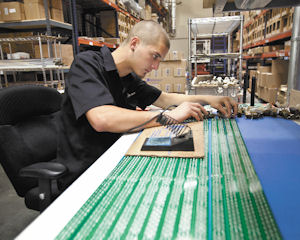Lighting manufacturer Seesmart Inc. is adding employees to its Simi Valley location as the company cuts back on using contract manufacturers in China. Producing LED products in the U.S. costs the startup company 3 percent more than manufacturing in China and opens up the possibility of supplying federal government buildings. LED, or light-emitting diode, lights are more efficient and less costly than fluorescent lighting. As a result, demand for the lights from both the commercial and industrial sectors is growing, industry experts said. The publicly-traded company had $6 million in revenues in 2010, a figure expected to double this year, said Chief Operating Officer Brooke Wagner. He expects revenues to climb to $25 million in 2012. The company plans to reinvest earnings to build a larger manufacturing plant, Wagner said. “That is our objective in 2012,” he said. Seesmart employs 25 people in Simi Valley in administrative, showroom, warehouse and manufacturing positions. In the second quarter, the company employed nine people in product assembly, Wagner said. Wagner could not say exactly how many manufacturing jobs will open up. A challenge of a startup is managing growth and the number of positions is in flux, he added. There are other benefits to making lights domestically, such as not having to deal with shipping costs, Wagner said. That, in turn, fits in with Seesmart’s corporate philosophy of being sensitive to the environment. “If we are reducing transportation costs, it is reducing emissions,” Wagner said. Simi Valley officials have been in discussions with Seesmart for about a year to discuss how to retain the company in the city, said Brian Gabler, assistant city manager and director of economic development. The city values manufacturers and the jobs they bring to the area, he said. In September, Seesmart did more manufacturing in Simi Valley than it did through its third-party vendors in China. In October, that situation had reversed, Wagner said. The 12,000-foot Ventura County site can accommodate more manufacturing space, but it would still be at capacity by next year given the anticipated growth, Wagner said. There are some Seesmart products, such as tube lights, where it makes sense to continue manufacturing in China. The high volume work, on the other hand, makes sense in the U.S., Wagner added. “If we are doing the high volume here, we can get the economies of scale ourselves,” Wagner added. Seesmart’s decision to shift some manufacturing back the U.S. follows a pattern set by others in the lighting industry. China is no longer the automatic choice when U.S. companies make light bulbs, said Terry McGowan, director of technology for the American Lighting Association. Overseas manufacturing can delay getting goods to market. What’s more, setting up a supply chain and keeping tabs on quality can be time-consuming, McGowan said. “Logistics cost money and it is competitive market,” he added. Office buildings, parking garages, warehouses, and manufacturing facilities use Seesmart lights. The General Services Administration has approved the lights for federal buildings, and this month, the California Department of General Services issued a contract that grants state and local governments the ability to purchase Seesmart lights at federal government prices. LED lights have gained more traction in commercial and industrial settings than residential settings because there is a cost benefit to the installation. “If you show a payback in a reasonable time, you can move the technology in place even thought it has a higher initial cost,” McGowan said. LED lights can cost $50 to $60 each, but have demonstrated one of the fastest returns on investment of any green technology, Wagner said. One Seesmart customer, a dry cleaner, spent $330,000 to install an LED lighting system. In the first year, the business will save $200,000 in electric costs and the system will pay for itself in 19 months, Wagner said. “Find me an investment that will give that kind of return.”
